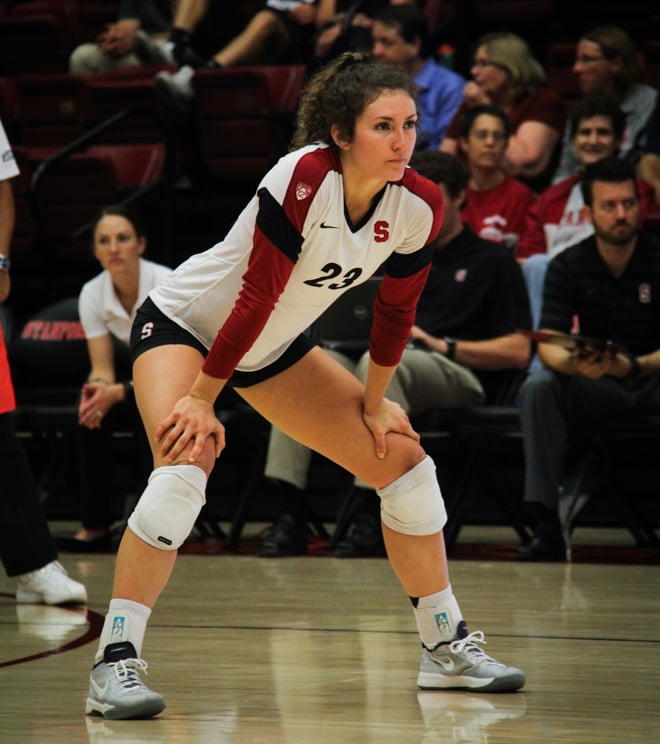Being around Stanford’s women’s volleyball team this season, there are two players that are simply impossible to miss — both on and off the court. Towering 6-foot-8 sophomore Merete Lutz and 6-foot-3 junior Inky Ajanaku have been the team’s anchors at the middle blocker position, becoming the targets of more and more passes as the season has gone on.

While the two came into this season with vastly different levels of experience — Lutz redshirted her freshman year, while Ajanaku, an AVCA First Team All-American last season, has started since her own freshman year — they have both made their mark nationally so far. The Cardinal’s middles rank No. 1 and No. 2 nationally in hitting percentage — Lutz at .528 and Ajanaku at .510 — and have just 28 errors combined on 385 total attacks.
So while No. 1 Stanford (12-0, 2-0 Pac-12) has always prided itself on having a balanced offense, most of their offensive output has come from their middles this year — even more than usual.
“One thing I’ve noticed that’s a lot different from other teams is how much we use our middles, especially in transition and in serve-receive,” said junior outside hitter Jordan Burgess. “A lot of times, teams will just set their outsides over and over again, but our offense is super diverse.”
But just as the spotlight has shifted in Stanford’s offense, so has the distribution of opportunities for its key offensive mainstays of yesteryear. Burgess, along with junior outside hitter Brittany Howard, have both seen fewer opportunities for kills this season, and have accordingly needed to adjust their mindsets on the court.
“Sixty percent of perfect passes go to our middles, pretty much. And then about 20 percent go to Morgan [Boukather] on the right,” said junior setter Madi Bugg. “The outsides get 20 percent of perfect passes to split, so they’re getting maybe four balls per game.
“But they’re getting splits in the block, opportunities to score, and then out of system, they’re getting balls. It’s just hard to get in rhythm, hard to take big swings and be confident when you haven’t been getting kills…We’re working on our outsides a lot and working on getting them into positions where they can score without having to swing out of system so much, since we set our middles so much in system.”
The Cardinal have not hit out of system very often early in their 2014 campaign, as they’ve almost always been in control — eight of their 12 wins have come in straight sets. But when they have, the outsides are usually the (unintended) targets.
“It’s a little bit different this year because Brittany and I get fewer perfect passes; we get less sets in those situations because it’s more out of system. But it’s actually really good for both of us to learn how to hit out of system better,” Burgess said. “The best outsides are really good at dealing with the hardest stuff that you get on the court — the crappy sets or balls that people are just trying to save, and you have to try to do something good with it.
“It was kind of similar to this last year at the beginning of the season and instead I just took it like every single time I got set, I needed to make good use of it. It’s about really trying to take your time, and when you’re not being set, look at what’s across the net and what you can do the next time when you do get the ball.”
Burgess has certainly made the most of her few offensive chances, while also contributing in big ways defensively. Her 2.67 kills per set average ranks third on the team, and her 3.21 digs per set ranks second behind only senior libero Kyle Gilbert.
Defense will certainly be important for the Cardinal this weekend against two quality opponents, particularly in No. 11 Oregon (12-0, 2-0) on Friday night. The Ducks, one of three undefeated teams in the conference, run a 6-2 offense — six attackers, two setters — that ranks third in the Pac-12 with a .295 hitting percentage and third with 14.4 kills per set. Freshman setter Maggie Scott (6.87 assists per set) and senior setter Shellsy Ashen (5.58 assists per set) command the offense.
“The main thing about Oregon is that their offense is super fast: to the pins, to the middles, to the back row — it’s all fast. So getting our block in order and adjusting our defense so that we dig as many balls as possible without having to move as much, and being able to avoid their block,” Bugg said.
Oregon State (11-2, 1-1) will arrive at Maples Pavilion on Saturday night, looking for their first win ever against Stanford. The Cardinal are 56-0 all-time against the Beavers, and haven’t dropped a set to them since 2011.
One thing Stanford will have to contend with on Saturday, however, is a big block. Oregon State leads the Pac-12 and ranks sixth nationally with 3.12 blocks per set, led by senior middle blocker Arica Nassar, whose 1.73 blocks per set top the conference.
First serve for Friday’s match against Oregon is set for 7 p.m. at Maples Pavilion. The match will be televised on ESPNU.
Contact Jordan Wallach at jwallach ‘at’ stanford.edu.
